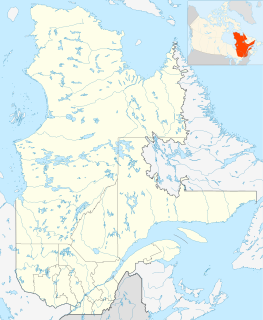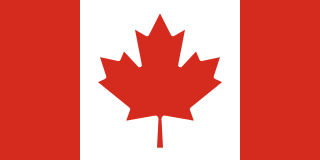
The Irish diaspora refers to ethnic Irish people and their descendants who live outside the island of Ireland.

Huguenots were a religious group of French Protestants.

The Catholic Church in Canada is part of the worldwide Catholic Church, under the spiritual leadership of the Pope. As of 2011, it has the largest number of adherents to a Christian denomination and a religion in Canada, with 38.7% of Canadians being adherents according to the census in 2011. There are 73 dioceses and about 7,000 priests in Canada. On a normal Sunday, between 15 and 25 per cent of Canada's Catholics attend Mass.

Irish Catholics are an ethnoreligious group native to Ireland that are both Catholic and Irish. Irish Catholics have a large diaspora, which includes more than 10 million Americans.

Irish Canadians are Canadian citizens who have full or partial Irish heritage including descendants who trace their ancestry to immigrants who originated in Ireland. 1.2 million Irish immigrants arrived from 1825 to 1970, and at least half of those in the period from 1831–1850. By 1867, they were the second largest ethnic group, and comprised 24% of Canada's population. The 1931 national census counted 1,230,000 Canadians of Irish descent, half of whom lived in Ontario. About one-third were Catholic in 1931 and two-thirds Protestant.

The Irish are an ethnic group and nation native to the island of Ireland, who share a common Irish ancestry, identity and culture. Ireland has been inhabited for about 12,500 years according to archaeological studies. For most of Ireland's recorded history, the Irish have been primarily a Gaelic people. From the 9th century, small numbers of Vikings settled in Ireland, becoming the Norse-Gaels. Anglo-Normans conquered parts of Ireland in the 12th century, while England's 16th/17th-century conquest and colonisation of Ireland brought many English and Lowland Scots people to parts of the island, especially the north. Today, Ireland is made up of the Republic of Ireland and the smaller Northern Ireland. The people of Northern Ireland hold various national identities including British, Irish, Northern Irish or some combination thereof.

Irish Quebecers are residents of the Canadian province of Quebec who have Irish ancestry. In 2006, there were 406,085 Quebecers who identified themselves as having partial or exclusive Irish descent in Quebec, representing 5.5% of the population.
The Demographics of Montreal concern population growth and structure for Montreal, Quebec, Canada. The information is analyzed by Statistics Canada and compiled every five years, with the most recent census having taken place in 2016.

French Americans or Franco-Americans, are citizens or nationals of the United States who identify themselves with having full or partial French or French Canadian heritage, ethnicity and/or ancestral ties. On the French-Canadians see French Canadian Americans.

The Aspotogan Peninsula is a peninsula in the eastern part of Lunenburg County, Nova Scotia, separating St. Margarets Bay in the east from Mahone Bay in the west. The peninsula was originally settled by second generation French immigrants on the east side and by second generation German immigrants on the west side. Traditionally fishing was a major industry for communities throughout the peninsula, however other primary industries such as farming and forestry were historically important as well. Shipping and shipbuilding were secondary and tertiary industries that also came into prominence during the 19th and early 20th centuries.

Grosse Isle, is located in the St. Lawrence River in Quebec, Canada. It is one of the islands of the 21-island Isle-aux-Grues archipelago. It is part of the municipality of Saint-Antoine-de-l'Isle-aux-Grues, located in the Chaudière-Appalaches region of the province.

The architecture of Quebec, was characterized in the beginning by the settlers of the rural areas along the St. Lawrence who largely came from Normandy. The houses they built echoed their roots. The surroundings forced enough differences that a unique style developed, and the house of the New France farmer remains a symbol of French-Canadian nationalism. These were rectangular structures of one storey, but with an extremely tall and steep roof, sometimes almost twice as tall as the house below. This roof design perhaps developed to prevent the accumulation of snow. The houses were usually built of wood, though the surviving ones are almost all built of stone. Landmarks in the rural areas were the churches and the mansion of the seigneurs. The seigneurs built much larger homes for themselves, but rarely were the manors ornate. Each parish had its church, often smaller copies of major churches in Quebec City or Montreal. A unique style of French-Canadian church thus developed.

The Great Migration of Canada was a period of high immigration to Canada from 1815 to 1850, which involved over 800,000 immigrants, mainly of British and Irish origin. Though Europe was becoming richer through the Industrial Revolution, population growth made the relative number of jobs low, forcing many to look to the New World for economic success, especially Canada and America.

Christianity is the most adhered to religion in Canada, with 67.3% of Canadians identifying themselves as of the 2011 census. The preamble to the Canadian Charter of Rights and Freedoms refers to God. The monarch carries the title of "Defender of the Faith". The French colonization beginning in the 17th century established a Roman Catholic francophone population in New France, especially Acadia and Lower Canada. British colonization brought waves of Anglicans and other Protestants to Upper Canada, now Ontario. The Russian Empire spread Orthodox Christianity in a small extent to the tribes in the far north and western coasts, particularly hyperborean nomadics like the Inuit; Orthodoxy would arrive to the mainland with immigrants from the Soviet Union, Eastern Bloc, Greece and elsewhere during the 20th century.
The typhus epidemic of 1847 was an outbreak of epidemic typhus caused by a massive Irish emigration in 1847, during the Great Famine, aboard crowded and disease-ridden "coffin ships".

The history of Saint John, New Brunswick is one that extends back thousands of years, with the area being inhabited by the Maliseet and Miꞌkmaq First Nations prior to the arrival of European colonists. During the 17th century, a French settlement was established in Saint John. During the Acadian Civil War, Saint Johns served as the seat for the administration under Charles de Saint-Étienne de la Tour. The French position in Saint John was abandoned in 1755, with British forces having taken over the area shortly afterwards.

Irish Americans are Americans who have full or partial ancestry from Ireland. About 33 million Americans — 10.1% of the total population — identified as being Irish in the 2017 American Community Survey conducted by the U.S. Census Bureau. This compares with a population of 6.9 million people on the island of Ireland.
English-speaking Quebecers are terms used to refer to English-speaking residents of Quebec. Anglo-Quebecers (anglophone) are a minority in the officially French-speaking (francophone) province of Quebec, Canada. The English-speaking community in Quebec constitutes an official linguistic minority population under Canadian law.













